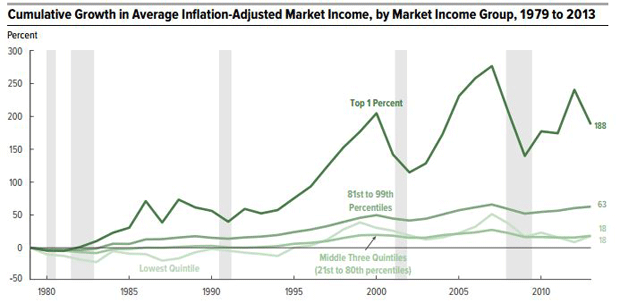The top 1 percent is thriving. Everyone else? Meh
Life is good for the very rich. For everyone else, it's a case of muddling along.
The top 1 percent saw their incomes jump by 188 percent from 1979 to 2013, according to a new report from the Congressional Budget Office. But incomes for the middle- and lower-income families rose just 18 percent during the same time period, the study found.
Stagnating and even falling incomes for low- and middle-income Americans have taken center stage in the presidential election, with voters expressing dissatisfaction at eroding standards of living. The wealthiest Americans, meanwhile, are benefiting from the "Matthew effect," a term coined after the Bible verse that describes how the rich cultivate more riches while everyone else loses out.
In America, the phenomenon is affecting almost every area of life, from health outcomes to educational choices.
"As the distributions of income have shifted over time, so has the degree of inequality in market income, before-tax income, and after-tax income," the CBO said in its report.
The Gini index, which is a measure of inequality, has correspondingly increased during the same period. In this measure, 0 indicates total equality while 1 indicates complete inequality.
America's Gini index for market income -- which the CBO defines as income from labor, business, capital gains and retirement income, but excluding government benefits from programs like Social Security -- was 0.48 in 1979. That had jumped to 0.60 by 2013, the CBO said.
The typical American household earned market income of $86,000 in 2013, while government benefits added another $14,000 per household, providing pretax income of $100,000. The average tax per household was about 20 percent, or $20,000 annually, leaving consumers with about $80,000 in annual aftertax income.
The situation is quite different for the top 1 percent. About 1.2 million households make up the highest-earning slice of America, pulling in an average of $1.6 million annually per household.
The richest Americans' wealth increased, thanks to ballooning paychecks and business income. Back in the early 1980s, the average annual paycheck for the 1 percent was about $200,000, adjusted for 2013 dollars. But since 2010, their annual income has jumped to about $600,000, the CBO said. Income from businesses has also risen rapidly, jumping from about $50,000 per year to more than $350,000.
So is there any good news for low- and middle-income families? One takeaway is that changes in the federal tax system in 2012 and 2013 helped make it the most progressive since the mid-1990s, the CBO said. Tax rates for the top 1 percent rose more than 5 percentage points during that two-year period.
The CBO added: "Despite the increases in tax rates in 2013, average federal tax rates in that year were below the 35-year average for most households."
